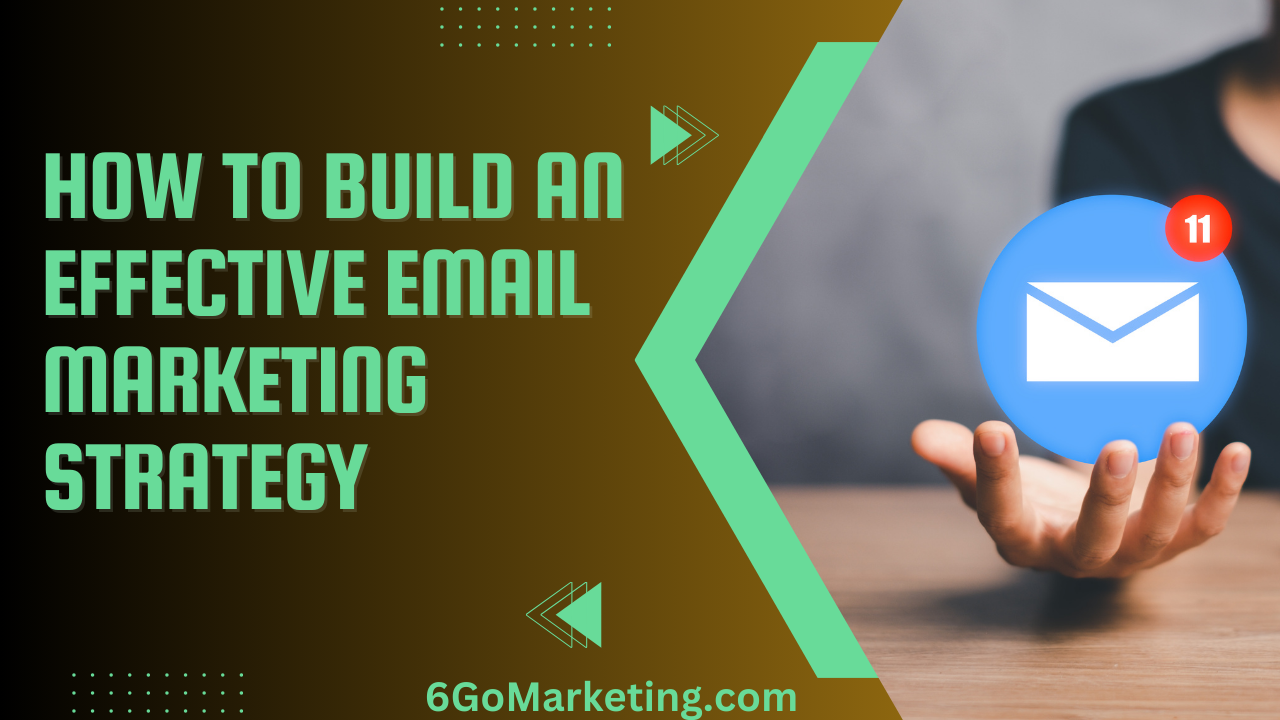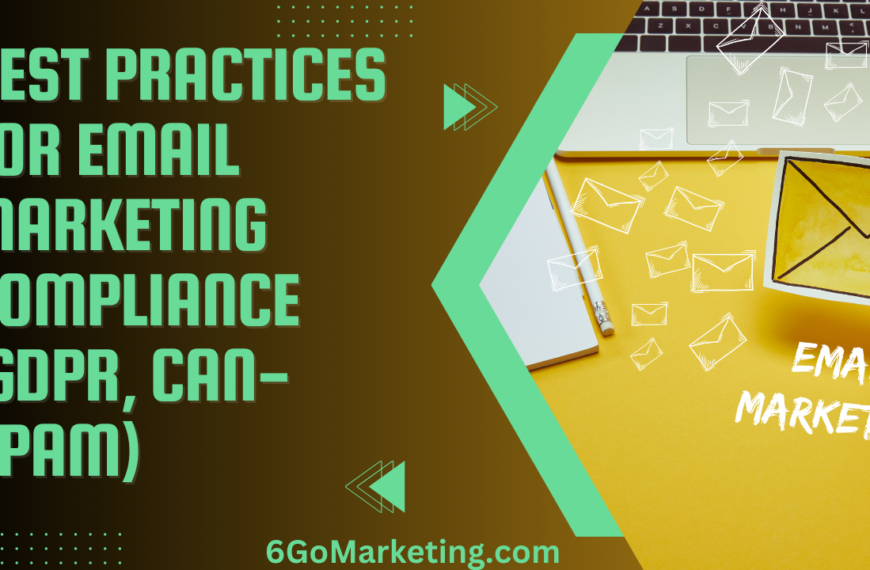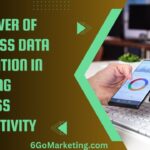Email marketing remains one of the most powerful tools for businesses to connect with their audience, build relationships, and drive conversions. With over 4.6 billion email users worldwide, businesses that can effectively leverage email marketing can enjoy high ROI, increased brand loyalty, and sustained customer engagement. However, creating a successful email marketing strategy requires careful planning, audience segmentation, compelling content, and ongoing optimization.
In this comprehensive guide, we’ll explore how to build an effective email marketing strategy from scratch, covering everything from list building to creating engaging content, automating campaigns, and tracking performance.
Why Email Marketing is Important
Email marketing is a direct communication channel that allows businesses to engage with their customers in a personalized and meaningful way. Whether it’s promoting products, sharing company updates, or nurturing leads, email marketing offers unique advantages:
- High Return on Investment (ROI): According to a study by Litmus, email marketing can deliver an ROI of $42 for every $1 spent.
- Direct Access to Audience: Emails land directly in a subscriber’s inbox, ensuring higher visibility compared to social media posts, which can get lost in feeds.
- Personalized Communication: Email marketing allows businesses to segment their audience and send tailored messages that resonate with their preferences and behaviors.
- Measurable Results: Email marketing platforms offer detailed analytics, allowing businesses to track open rates, click-through rates, conversions, and more.
Quote: “Email marketing is one of the most cost-effective tools in a marketer’s arsenal. With the right strategy, it can drive significant engagement and revenue.” — Mark Reynolds, Digital Marketing Expert
Step-by-Step Guide to Building an Effective Email Marketing Strategy
1. Set Clear Goals for Your Email Marketing Campaign
Before starting any email marketing campaign, it’s essential to define your goals. Having clear objectives will guide your content creation, audience segmentation, and campaign structure.
Common Email Marketing Goals:
- Increase Website Traffic: Encourage subscribers to visit your website by promoting new blog posts, product pages, or special offers.
- Boost Product Sales: Promote specific products or services through special offers, discounts, or time-sensitive deals.
- Grow Subscriber List: Use email marketing to attract new subscribers through lead magnets or gated content.
- Nurture Leads: Educate and build relationships with potential customers by sending them relevant content that addresses their pain points.
- Engage Existing Customers: Keep existing customers informed about new product launches, company updates, or loyalty programs.
Example Table: Common Email Marketing Goals and Metrics
| Goal | Description | Key Performance Indicators (KPIs) |
|---|---|---|
| Increase Website Traffic | Drive traffic to your website via email links | Click-through rates, website visits |
| Boost Product Sales | Encourage purchases through promotional emails | Conversion rates, revenue generated |
| Grow Subscriber List | Expand your email list with new subscribers | List growth rate, opt-ins, lead magnet downloads |
| Nurture Leads | Provide valuable content to turn leads into customers | Open rates, engagement, lead-to-customer conversion |
| Engage Existing Customers | Keep customers informed and loyal | Repeat purchases, customer retention |
2. Build a Targeted Email List
An effective email marketing strategy starts with building a quality email list. Your list should consist of people who are genuinely interested in your business, products, or services. There are several methods to grow your email list organically:
List-Building Techniques:
- Use Lead Magnets: Offer valuable resources such as eBooks (you can also use an ebook generator to create an ebook for you), checklists, templates, or exclusive discounts in exchange for a visitor’s email address.
- Create Opt-In Forms: Place opt-in forms on your website, especially on high-traffic pages such as your homepage, blog, and product pages. Make sure the form is easy to fill out.
- Run Contests and Giveaways: Hosting a contest or giveaway is a great way to encourage people to subscribe to your email list.
- Use Social Media: Promote your email newsletter or lead magnet on social media platforms to drive new subscribers.
- Include a Sign-Up Link in Your Email Signature: Add a link to your email newsletter sign-up form in your business email signature for easy access.
Best Practices for Growing Your Email List:
- Get Explicit Consent: Always ensure you have permission before adding someone to your email list. Use double opt-ins to confirm interest. This is particularly important for sensitive topics, such as funeral planning or services, where individuals may want clear communication and respect for their preferences.
- Provide Clear Value: Clearly explain the benefits of subscribing to your email list, such as receiving exclusive content, offers, or updates.
- Segment Your List: As your list grows, segment subscribers based on their interests, behaviors, or demographics to send more personalized emails.
Example Table: Effective Lead Magnets for Different Industries
| Industry | Lead Magnet Idea | Benefit to the Audience |
|---|---|---|
| E-commerce | Discount codes, early access to sales | Encourages immediate action, drives sales |
| SaaS | Free trials, case studies | Allows users to experience the product before committing |
| Digital Marketing | Free templates, content calendars | Offers practical tools for marketers |
| Health and Fitness | Meal plans, workout guides | Provides actionable advice for healthy living |
| Education | Free courses, eBooks | Helps users gain knowledge and improve skills |
3. Segment Your Email List
Email segmentation involves dividing your subscriber list into smaller, targeted groups based on various criteria, such as demographics, behaviors, purchase history, or interests. Segmentation allows you to send highly relevant and personalized content, which can significantly improve engagement and conversion rates.
Common Segmentation Criteria:
- Demographics: Age, gender, location, or job title.
- Behavioral: Purchase history, website activity, or email engagement.
- Interest-Based: Products or services they’ve shown interest in, based on past behavior or expressed preferences.
- Stage of the Customer Journey: New subscribers, leads, repeat customers, or inactive subscribers.
Benefits of Segmentation:
- Increased Relevance: Targeted content increases the likelihood of engagement by delivering content that matches the subscriber’s interests.
- Improved Open Rates: Subscribers are more likely to open emails that are relevant to them.
- Higher Conversion Rates: Personalizing content based on customer preferences can lead to more conversions and sales.
Example Table: Segmentation Strategies for Different Types of Businesses
| Business Type | Segmentation Criteria | Example Campaign |
|---|---|---|
| E-commerce | Purchase history | Product recommendations based on past purchases |
| B2B | Job title, industry | Targeted emails with industry-specific content |
| SaaS | Trial vs. paying customers | Trial customers receive onboarding emails; paying customers get product updates |
| Non-profit | Donation history | Personalized donation requests based on previous contributions |
| Travel | Location, previous bookings | Location-specific travel deals or promotions |
4. Create Compelling and Engaging Content
Content is the heart of your email marketing strategy. Your emails need to provide value, capture attention, and drive action. Whether you’re sending a newsletter, promotional email, or nurturing sequence, your content should be relevant, engaging, and aligned with your audience’s needs.
Types of Email Content:
- Newsletters: Keep your audience informed with company updates, industry news, or blog highlights. Use engaging newsletter templates for better results.
- Promotional Emails: Announce sales, discounts, or new products with a clear call-to-action (CTA).
- Transactional Emails: Send order confirmations, shipping updates, or receipts for purchases.
- Educational Content: Provide valuable resources, such as how-to guides, tutorials, or case studies, to educate your audience.
- Drip Campaigns: A series of automated emails sent over time to nurture leads, onboard new customers, or re-engage inactive subscribers. This includes lead nurture email examples demonstrating how to guide leads through the sales funnel.
Best Practices for Email Content:
- Write Compelling Subject Lines: Your subject line is the first thing recipients see, and it can make or break your open rates. Keep it short, intriguing, and relevant to the content of the email.
- Personalize Your Emails: Use the subscriber’s name, reference past interactions, and tailor the content based on their preferences or behavior.
- Use Clear CTAs: Each email should have a clear and compelling call-to-action that guides readers toward the next step, whether it’s visiting your website, making a purchase, or downloading a resource.
- Include Visuals: Images, GIFs, and videos can make your emails more engaging and visually appealing.
- Optimize for Mobile: Over 60% of emails are opened on mobile devices, so it’s essential to ensure your emails are mobile-friendly.
Example Table: Types of Email Content and Their Purposes
| Content Type | Purpose | When to Use |
|---|---|---|
| Newsletter | Keep subscribers informed, provide updates | Regular communication with subscribers |
| Promotional Email | Announce sales, new products, or limited-time offers | When launching a sale or promotion |
| Educational Content | Teach, inform, or offer valuable insights | Nurture leads, build trust with customers |
| Drip Campaign | Automate communication to nurture leads | Onboarding, lead nurturing, or re-engagement |
| Transactional Emails | Confirm purchases or updates on orders | After a customer makes a purchase |
5. Optimize Your Email Design for Better Engagement
A well-designed email not only looks professional but also improves engagement and encourages action. Email design should be visually appealing, easy to read, and aligned with your brand identity. Good design can enhance your content and drive higher click-through rates.
Email Design Best Practices:
- Use a Clear Layout: Organize your email with a simple and clean structure. Avoid clutter by using white space effectively, which makes the content easier to scan.
- Responsive Design: Ensure your email design is mobile-friendly. Over 60% of emails are opened on mobile devices, so use responsive design to ensure it looks good on all screen sizes.
- Incorporate Branding Elements: Consistently use your brand’s colors, fonts, and logo design to create a cohesive experience for your audience. This strengthens brand recognition. By using an AI logo generator, businesses can quickly create professional and customized logos that align with their branding, ensuring a unified look across all platforms.
- Highlight Key Information: Use headings, subheadings, and bullet points to break up text and make it easier for readers to find important information.
- Test Email Templates: Use different email templates for various campaigns and test which ones perform best in terms of engagement and conversions.
Use of Visuals:
Visual content like images, GIFs, and infographics created with Visme’s AI image generator can make your emails more engaging. However, balance is key—too many images can slow down load times or cause layout issues on mobile devices.
Example Table: Key Elements of Effective Email Design
| Element | Purpose | Best Practices |
|---|---|---|
| Responsive Design | Ensures emails display correctly on all devices | Use mobile-friendly templates and test on different screen sizes |
| Branding Elements | Reinforces brand identity | Use consistent colors, fonts, and logos |
| Visuals | Engages readers and adds appeal | Use high-quality, optimized images |
| Layout | Organizes content for readability | Use a clear, simple structure with plenty of white space |
| Call-to-Action (CTA) | Encourages reader action | Use prominent buttons with actionable text |
6. Automate Your Email Campaigns
Automation is a key component of an effective email marketing strategy. By automating certain types of emails, you can deliver relevant content at the right time without manually sending each message. Automation helps you nurture leads, onboard new customers, and re-engage inactive subscribers efficiently.
Common Types of Automated Emails:
- Welcome Emails: Greet new subscribers with an automated welcome series, introducing them to your brand and offering something of value (e.g., a discount code or free resource).
- Drip Campaigns: Send a series of emails over time based on user actions, such as downloading an eBook or signing up for a free trial.
- Abandoned Cart Emails: Remind customers who added items to their cart but didn’t complete the purchase. These emails often include incentives like a discount to encourage them to return and complete their order.
- Re-Engagement Campaigns: Automatically send emails to subscribers who haven’t interacted with your content in a while. These emails can remind them of what they’re missing and encourage them to reconnect with your brand.
Benefits of Automation:
- Saves Time: Once set up, automated emails require little ongoing management, allowing you to focus on other aspects of your business.
- Increases Engagement: Automated emails are timely and relevant, leading to higher open and click-through rates.
- Personalization: Automation allows you to send personalized emails based on user behavior, preferences, and actions, improving the customer experience.
Example Table: Types of Automated Email Campaigns
| Campaign Type | Description | When to Use |
|---|---|---|
| Welcome Series | Introduces new subscribers to your brand | After a user signs up for your email list |
| Abandoned Cart Emails | Reminds users of items left in their cart | After a user abandons their cart without completing a purchase |
| Lead Nurturing Drip Campaigns | Sends a series of emails to nurture leads | After a lead downloads a resource or shows interest in your product |
| Re-Engagement Campaigns | Tries to re-engage inactive subscribers | When subscribers haven’t interacted with emails for a while |
7. Personalize Your Emails
Personalization is one of the most effective ways to improve email marketing performance. Personalized emails feel more relevant and increase the likelihood of engagement. In fact, studies show that personalized emails deliver six times higher transaction rates compared to non-personalized emails.
Ways to Personalize Emails:
- Use Subscriber’s Name: Address subscribers by their first name in the subject line or email body.
- Segmented Campaigns: Use audience segments to send content tailored to the specific interests or behaviors of each group.
- Behavioral Triggers: Create visuals by including attachments in your emails more efficiently by compressing PDF files to reduce their size, ensuring quicker uploads, easier sharing, and smoother delivery without exceeding file size limits.
- Dynamic Content: Use dynamic email content that changes based on the recipient’s preferences or past interactions. For example, you could show different product recommendations to different segments of your audience.
Benefits of Personalization:
- Increased Engagement: Personalized emails are more likely to be opened and clicked, leading to higher engagement.
- Improved Customer Experience: Sending relevant content enhances the customer’s overall experience with your brand.
- Higher Conversions: Personalized product recommendations, special offers, or targeted content can lead to higher conversion rates.
Quote: “The key to successful email marketing is relevance. The more personalized and relevant your emails, the more likely your audience is to engage with them.” — Emily Parker, Email Marketing Consultant
Example Table: Personalization Techniques and Their Impact on Email Campaigns
| Personalization Technique | Description | Impact on Campaign Success |
|---|---|---|
| Using Subscriber’s Name | Adds the recipient’s name to the subject line or greeting | Increases open rates and builds connection |
| Behavioral Triggers | Sends emails based on user actions | Improves relevance and timeliness |
| Dynamic Content | Displays content based on user preferences | Enhances engagement and conversion rates |
| Segmented Campaigns | Sends tailored content to different audience segments | Improves targeting and overall email performance |
8. Test and Optimize Your Campaigns
Testing is a critical part of any email marketing strategy. Regularly testing different elements of your campaigns allows you to optimize them for better performance. By using A/B testing, you can experiment with various elements, such as subject lines, email content, CTAs, and send times.
A/B Testing Elements:
- Subject Lines: Test different subject lines to see which ones result in higher open rates.
- Email Content: Experiment with different types of content, such as images, videos, or text-heavy emails.
- CTAs: Test the placement, design, and wording of your call-to-action buttons to determine what drives the most clicks.
- Send Times: Try sending emails at different times of the day or week to determine when your audience is most likely to engage.
Email Marketing Metrics to Monitor:
- Open Rates: The percentage of people who opened your email. This helps determine how effective your subject line and sender name are.
- Click-Through Rates (CTR): The percentage of recipients who clicked on a link within the email. This measures the effectiveness of your content and CTAs.
- Conversion Rates: The percentage of subscribers who completed the desired action (e.g., making a purchase or signing up for an event) after clicking through.
- Bounce Rates: The percentage of emails that couldn’t be delivered to recipients. High bounce rates may indicate problems with your email list.
Example Table: Key Email Marketing Metrics and Their Significance
| Metric | Description | Significance |
|---|---|---|
| Open Rate | Percentage of recipients who opened the email | Measures the effectiveness of subject lines and sender names |
| Click-Through Rate (CTR) | Percentage of recipients who clicked a link | Indicates the effectiveness of content and CTA |
| Conversion Rate | Percentage of recipients who completed a desired action | Measures the overall success of the campaign |
| Bounce Rate | Percentage of emails that failed to deliver | Identifies potential issues with your email list or sender reputation |
9. Ensure Compliance with Email Regulations
To maintain trust with your subscribers and avoid legal penalties, it’s important to comply with email marketing regulations such as GDPR (General Data Protection Regulation) and CAN-SPAM Act. Non-compliance can result in fines and damage to your brand’s reputation.
Key Compliance Practices:
- Obtain Explicit Consent: Ensure subscribers give explicit permission to receive your emails. This is typically done through a sign-up form or double opt-in process.
- Provide an Unsubscribe Option: Every email should include a clear way for subscribers to opt out of future emails. Make the unsubscribe process simple and immediate.
- Include Your Physical Mailing Address: The CAN-SPAM Act requires that all commercial emails include the sender’s physical postal address.
- Maintain Privacy Policies: Be transparent about how you collect, store, and use subscriber data. Include a link to your privacy policy in your emails.
Conclusion
Email marketing remains one of the most powerful digital marketing tools, offering a direct line of communication with your audience. By following the steps outlined in this guide, you can create an effective email marketing strategy that drives engagement, conversions, and long-term customer loyalty.
Start by setting clear goals, building a quality email list, and segmenting your audience to deliver relevant and personalized content. Use compelling designs and effective calls to action to guide subscribers toward taking the desired actions, whether that’s visiting your website, making a purchase, or signing up for an event. Automation can save time and improve customer journeys, while regular A/B testing and data analysis ensure continuous improvement.
Finally, don’t forget to comply with email regulations like GDPR and the CAN-SPAM Act to maintain the trust and privacy of your subscribers. When done right, email marketing can offer high ROI, build stronger customer relationships, and significantly boost your business’s growth.
Quote: “Email marketing is a balance between creativity and strategy. When executed well, it becomes a consistent driver of business growth and customer engagement.” — Mark Johnson, Digital Marketing Expert










